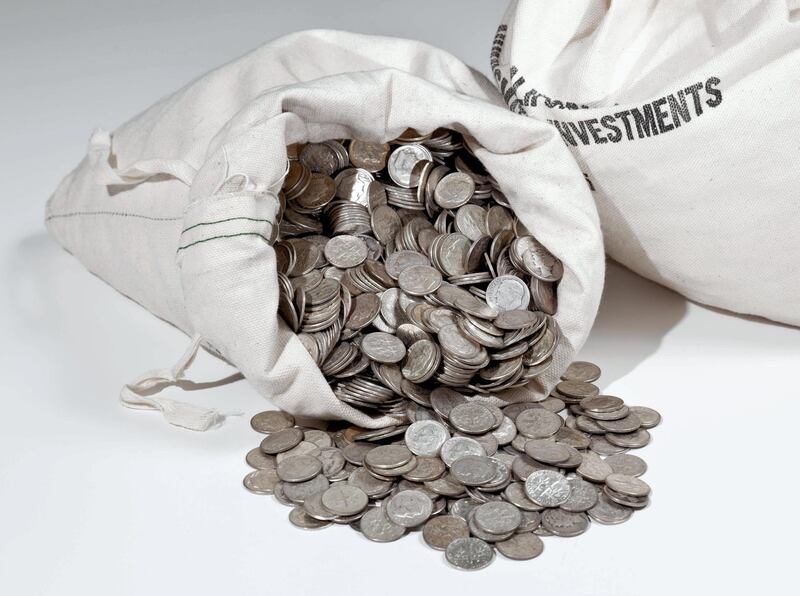While gold prices rose by almost 13 per cent in 2017, their best year since 2010, the precious metal’s precious shinier sister silver only managed half that gain.
Usually it is the other way around with silver acting as a leveraged play on the gold price. Ergo higher gold prices generally mean even higher silver prices.
So has something fundamental changed? Or could silver snap back with some really spectacular gains in 2018, particularly if the nascent bull market in gold we have seen so far this year picks up speed?
Could that make silver the standout choice for maximum gain in a year when commodities significantly outpace stocks, bonds and real estate?
Bear in mind that we have already seen $70-a-barrel oil in January, only last month regarded as a slightly ambitious prediction for the entire year.
It was certainly the case in 2011, when gold hit an all-time high of $1,923 an ounce, that silver put in an even better performance, coming within a whisker of its 1980 all-time high of $48.
But why did silver underperform last year? It should have been doing better if the relationship between the prices of the two precious metals was to hold true.
Well goldbugs tell me it is not unusual for gold to lead off a new bull market in precious metals. It’s always gold that is in the headlines and it’s gold that they stack away in the central bank vaults of the world.
However, the unmistakable fact is that the above ground stock of silver in the world is but a tiny fraction of gold reserves and the supply of silver is relatively fixed. Hence this is a tighter market and it does not take much of an increase in demand to juice prices strongly upwards.
There is something else you need to know about silver. JP Morgan has allegedly cornered this market over the last seven years. Today 45 per cent, or 675 million ounces, of all above ground silver is now controlled by this single bullion bank, according to veteran silver analyst Theodore Butler.
He contends that JP Morgan has been suppressing the price of silver for many years so that it could accumulate this quantity of silver at low prices. Now in the past silver prices have always eventually spiked highest when a monopolist was at work in the market place.
______
Read more from Peter Cooper:
Will 2018 mirror 2011 as a landmark year for precious metals?
12 festive tips on how to invest in 2018
Could gold do a bitcoin and hit $10,000 an ounce in 2018?
What to buy when the stock market crashes
______
In the 1970s it was the Hunt Brothers, two Texan oil men, who gradually cornered the market and forced the price of silver to its still unchallenged 1980 high of $48. Warren Buffett also managed to briefly control the silver market in the late 1990s and profit handsomely, despite gold being out of favour at the time.
Therefore JP Morgan’s position in the silver market, said to be bigger than the earlier Hunt or Buffett hoards, should not be ignored. It is not a guarantee that the silver price will take off to the moon in 2018, absent other events.
But given a new gold bull market it does most likely mean that its impact on silver prices will be even more exaggerated than in 2011. So where does the gold market stand today? In a much better place than it was a month ago would be the short answer. From a moment when Toronto gold analysts were saying gold was going nowhere in 2018, the precious metal has been challenging last summer's high of $1,350 and has taken out previous chart resistance levels.
It’s easy enough now to be wise after the event and say, ah well that was due to the falling US dollar. But how many commentators forecast that a month ago? Actually quite a few but they did not join the dots to the gold price.
What still seems to confuse gold analysts is the fact that gold pays no interest rate. Therefore they think higher interest rates will take money out of gold and into the US dollar.
However, it does not work that way. Gold prices have risen after each of the past four Federal Reserve rate rises. Higher interest rates are a sign of future economic confidence and inflation, which is good for gold.
Add in President Donald Trump’s tax cuts and you have a soaring deficit with a bigger national debt that makes holding US treasuries less attractive and depresses the value of the dollar. A falling dollar almost automatically raises the gold price.
Now looking forward you have to ask yourself, is this it or are we going to see more of the same?
I come back to the point I made in the final paragraphs of my last column on gold in this newspaper: 10-year US treasury yields are finally on the way up as they buckle under the weight of Federal Reserve rate increases and a growing US economy. Some say the bond bull market seen since 1981 is now dead.
That automatically lowers US bond prices as bond prices and yields move in opposite directions. It matters because all other financial instruments are benchmarked to US treasuries and they constitute the largest and most liquid pool of capital in the world.
Higher interest rates are a tax on business so that is also usually bad for the stock market, which in any case will have to compete with bonds by raising its dividend yields via lower equity prices. Real estate is obviously not happy with more expensive money either.
On the other hand, commodities are all priced in US dollars and are repriced upwards as the dollar falls. That explains the higher oil and copper prices we are seeing, and the sudden, and perhaps not so surprising, boost in gold prices.
But if you really want to play the commodities upturn cleverly, then buy what has been left behind in the price upturn so far, and that leaves you with silver, always loved by speculators for its volatility to the upside.
Silver was the top performer in 2011, the last big year for precious metals, and if 2018 is another landmark year then it most probably will be again.
Peter Cooper has been writing about finance in the Gulf for more than 20 years






